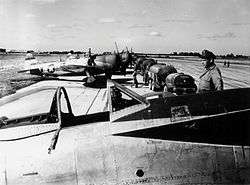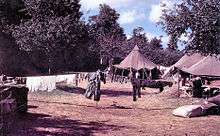Tour-en-Bessin Airfield
Tour-en-Bessin Airfield is an abandoned World War II military airfield, located near the commune of Tour-en-Bessin in the Normandy region of northern France.
| Tour-en-Bessin Airfield Advanced Landing Ground (ALG) A-13 | |||||||||
|---|---|---|---|---|---|---|---|---|---|
| Basse-Normandie Region, France | |||||||||
 Ground personnel of the 406th Fighter Group refuel P-47 Thunderbolts, including (serial number 44-33057) at Tour-en-Bessin Airfield | |||||||||
 Tour-en-Bessin Airfield | |||||||||
| Coordinates | 49°17′45″N 000°45′41″W | ||||||||
| Type | Military Airfield | ||||||||
| Site information | |||||||||
| Controlled by | |||||||||
| Site history | |||||||||
| Built by | IX Engineering Command | ||||||||
| In use | July–December 1944 | ||||||||
| Materials | Prefabricated Hessian Surfacing (PHS) | ||||||||
| Battles/wars | World War II - EAME Theater
| ||||||||
| Garrison information | |||||||||
| Garrison | |||||||||
| Occupants |
| ||||||||
| Airfield information | |||||||||
| |||||||||
| Two Runways, 4 alert pads, 50 hardstands[1] | |||||||||

The United States Army Air Force established a temporary airfield on 12 July 1944, shortly after the Allied landings in France. It was constructed by the IX Engineering Command, 833d and 846th Engineer Aviation Battalions.
History
Known as Advanced Landing Ground "A-13", the airfield consisted of a main 5000' (1500m) Pierced Steel Planking runway aligned 12/30 and a secondary 5000' PSP runway aligned 01/19. In addition, tents were used for billeting and also for support facilities; an access road was built to the existing road infrastructure; a dump for supplies, ammunition, and gasoline drums, along with a drinkable water and minimal electrical grid for communications and station lighting.[2]
The 373d and 406th Fighter Groups flew P-47 Thunderbolts from Tour en Bessin. The fighter planes flew support missions during the Allied push into France, patrolling roads, strafing German military vehicles and dropping bombs on gun emplacements, anti-aircraft artillery and concentrations of German troops in Normandy and Brittany when spotted. In addition, the B-26 Marauder 394th Bomb Group was assigned to the airfield. The bombers also attacked bridges and German-controlled airfields in occupied areas.
After the Americans moved east into Central France with the advancing Allied armies, the airfield was used as a resupply and casualty evacuation airfield for several months, before being closed on 2 December 1944. The land returned to agricultural use.[3]
Major units assigned
- 373d Fighter Group 19 July - 19 August 1944
- 410th (R3), 411th (U9), 412th (V5) Fighter Squadrons (P-47)[4]
- 406th Fighter Group 30 July - 17 August 1944
- 512th (L3), 513th (4P), 514th (O7) Fighter Squadrons (P-47)[4]
- 394th Bombardment Group 25 August - 18 September 1944
- 584th (K5), 585th (4T), 586th (H9), 587th (SW) Bombardment Squadrons (B-26)[4]
Current use
Today there is little or no physical evidence of the airfield's existence, although the south end of the 01/19 runway is visible by the curvature of some fields, and some slight ground disturbance in a field to the east probably is from the 12/30 runway.[5]
A memorial to the men and units that were stationed at Tour-en-Bessin was placed on the D613 (former N13) between Vaucelles and Tour-en-Bessin.
See also
References
![]()
- Tour-en-Bessin Airfield
- IX Engineer Command ETO Airfields, Airfield Layout
- Johnson, David C. (1988), U.S. Army Air Forces Continental Airfields (ETO), D-Day to V-E Day; Research Division, USAF Historical Research Center, Maxwell AFB, Alabama.
- Maurer, Maurer. Air Force Combat Units of World War II. Maxwell AFB, Alabama: Office of Air Force History, 1983. ISBN 0-89201-092-4.
- Johnson, David C. (1988), U.S. Army Air Forces Continental Airfields (ETO), D-Day to V-E Day; Research Division, USAF Historical Research Center, Maxwell AFB, Alabama
External links
| Wikimedia Commons has media related to Tour-en-Bessin Airfield. |
.svg.png)